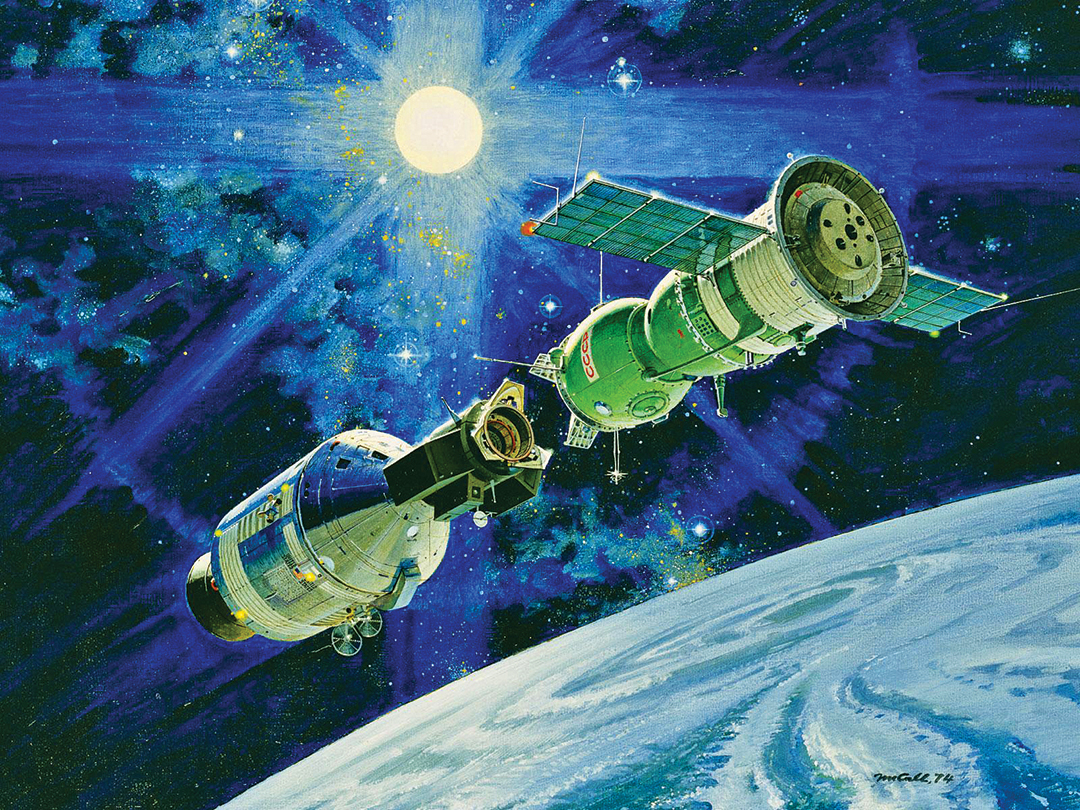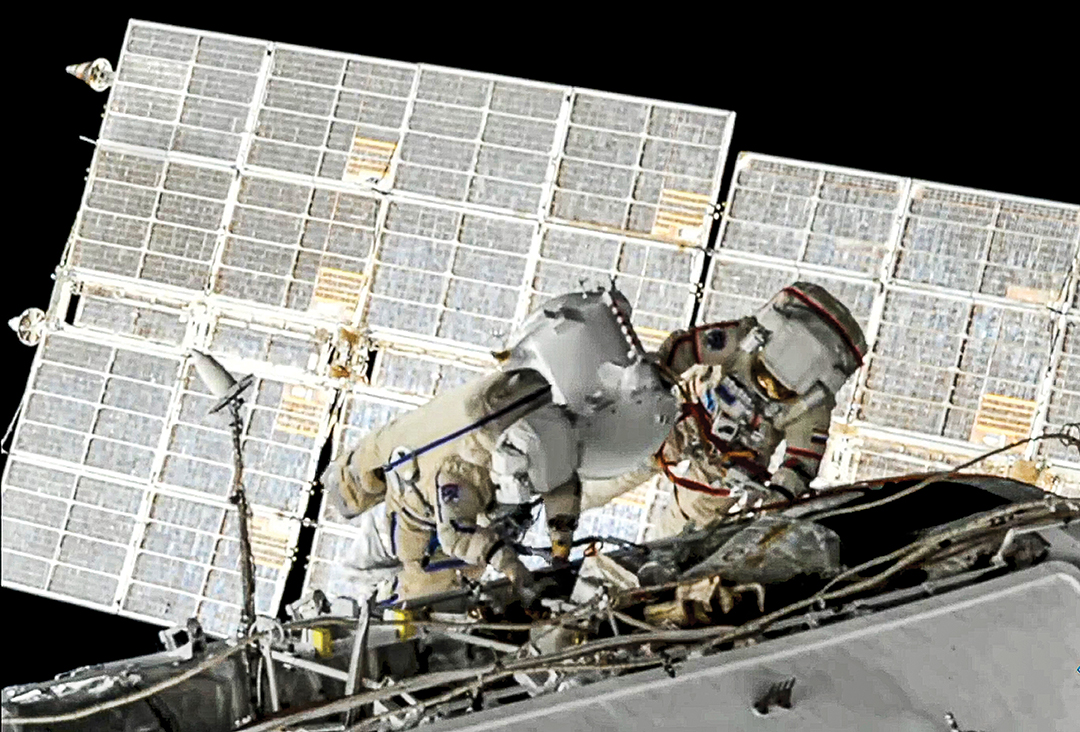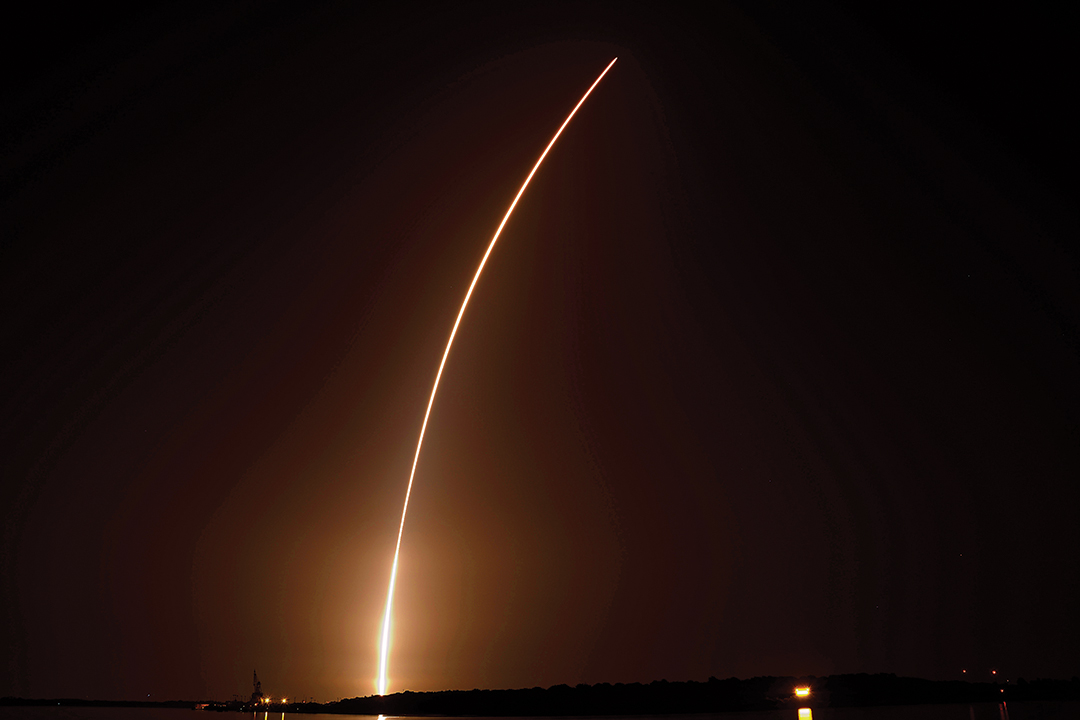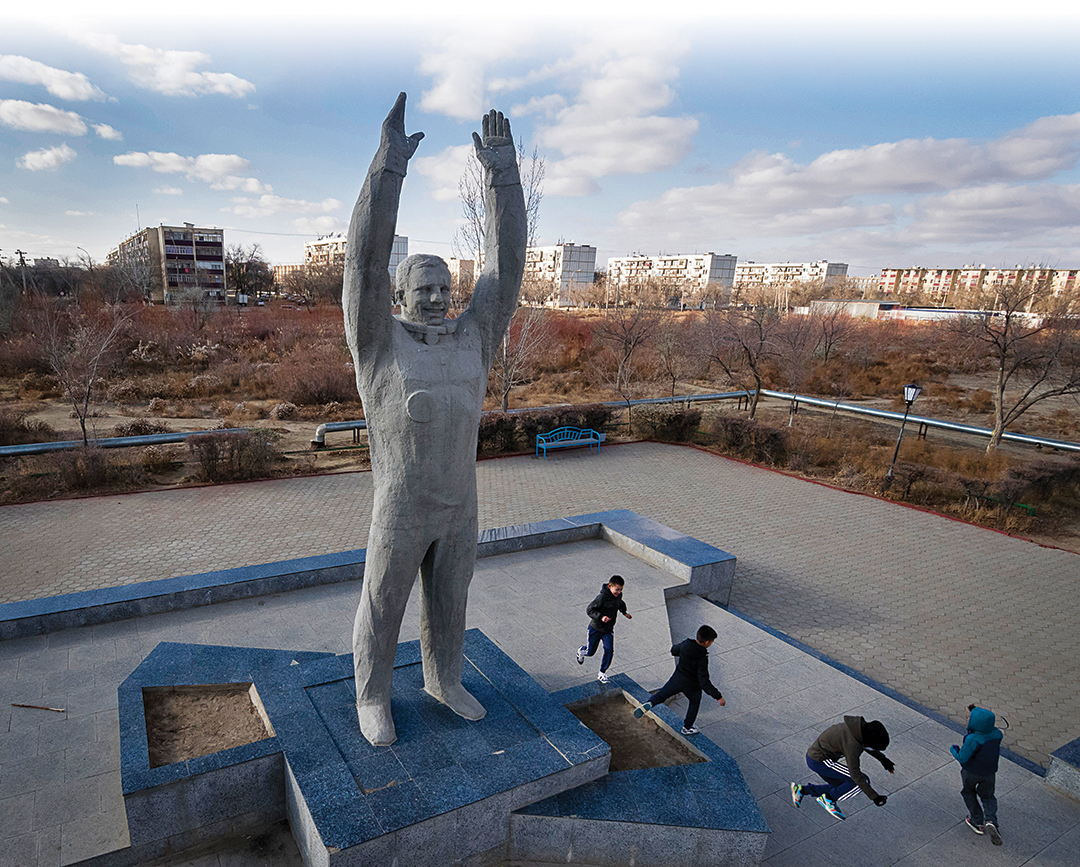By Dr. Paweł Bernat, security studies lecturer, Polish Military University of Aviation
The date July 17, 1975, is significant in the history of space exploration: A United States Apollo module docked with a Soviet Soyuz capsule, the first time the two countries had met in space. It marked what is broadly considered the end of the space race between the U.S. and the Soviet Union. The new era began with a Russian-American handshake approximately 140 miles above Earth.
Afterward, especially after the collapse of the Soviet Union, cooperation between the two space powerhouses intensified. More common projects were carried out, including an 11-mission program (1993-1998) that involved NASA space shuttles docking with the Russian Mir orbital station and American and European astronauts spending time with their Russian counterparts in space. The culmination of this cooperation between NASA and Roscosmos, the Russian space agency, was the construction of the International Space Station (ISS) that began in 1998. It has been continuously inhabited since 2000. In 2011, after 30 years in operation, the space shuttle program was retired, and the U.S. lost the capability to launch astronauts into space. Crews were carried to the ISS by Russian Soyuz spacecraft.
The space station is considered humanity’s most complex (and expensive) creation. Despite its high maintenance cost, it has helped to expand human knowledge and technology for more than two decades. Regardless of the political situation on Earth, the ISS has been an orbiting home of cooperation and mutual respect. The window view on the “blue dot” has provided a true global perspective — one on which international crises have had limited influence. Even Russia’s 2008 war with Georgia and its invasion and annexation of Crimea in 2014 — although significant for global politics — didn’t disrupt the well-established plan of crew changes and cargo launches.
Things, however, have started to change as the 21st century begins its third decade. Many signals point to a change in how, and more important, with whom, the Kremlin wants to partner to develop its future space program.

The rationale for the shift in Russia’s space policy is, of course, complex. The reasons for this apparent change in how Russia views space and how it plans missions can be divided into two groups of factors: recent changes in the global space sector and recent changes in Russia’s financial, political and even social situation.
Recent technological developments have affected Roscosmos in the global marketplace. In 2020, the U.S. was once again able to send astronauts into space. The Crew Dragon Demo-2 launched on May 30 that year, making it the first crewed test flight of the spacecraft that was built and operated by a private U.S. company, SpaceX. The past decade saw a rapid development of private companies successfully carrying out space missions. This new age of exploration, commonly called Space 2.0, is characterized by the commercialization and democratization of technologies. NASA saw that potential and supported private development of space technology and even started to outsource many services — including cargo and crew missions to the ISS. That became possible because many U.S. companies possess sufficient intellectual, technological and financial potential.
There is no such potential in Russia — the private space sector there is marginal, especially after the renationalization of the sector that started in 2013 and finished in 2016 with the establishment of the Roscosmos State Corporation. Roscosmos must now compete with new and cheaper satellite and crew launchers built and operated by private U.S. companies, especially SpaceX and its Falcon 9 semi-reusable rocket (the second stage is not reusable). As of October 16, 2021, there were 16 launches of Russia’s Soyuz 2-1.a and 2-1.b and 23 launches of the Falcon 9. The U.S. had 39 successful launches, China had 37, and Russia had 17. This is, however, just the beginning of the emergence of private space operators. Blue Origin — the company owned and managed by Amazon founder Jeff Bezos — launched its first human flight in July 2021. From the space-sector perspective, much more critical than Blue Origin’s New Shepard suborbital rocket is its New Glenn — the fully reusable two-stage launcher capable of lifting 45,000 kilograms into low Earth orbit that is scheduled to be operational in late 2022.
U.S. firm Rocket Lab has successfully launched its small Electron rocket multiple times. Virgin Orbit has tested its LauncherOne system and secured a contract worth $35 million for launching satellites. In June 2021, the company successfully launched its first commercial mission and placed seven satellites in low Earth orbit. Relativity Space, also a U.S. company, has developed 3D printing technology for manufacturing rockets and plans to launch its small Terran 1 rocket before the end of 2021. This list is by no means exhaustive. There are many more companies — small and large — that participate in the technological race that is Space 2.0. Next to these newcomers, there are well-established companies such as Boeing, Northrop Grumman Innovation Systems and United Launch Alliance (ULA).
Roscosmos, on the other hand, has been unable to fully develop new launchers. Two rockets are in use: Soyuz 2, which dates to 1966, but is the most-flown and statistically safest rocket ever produced, and the Proton rocket family that also is based on 1960s technology. Both systems have undergone upgrades, but in comparison to newly developed launchers, the technology is obsolete. The Russians have, of course, been working on a new family of rockets — the Angara. So far, there have been three test launches. Two took place in 2014, and one in 2020. The lack of stable financing has significantly delayed the program.

The second set of factors in the decline of the Russian space sector, at least in comparison to other countries, can be traced to internal processes within Russia. Those factors are not limited to funding and include the Kremlin’s current political agenda and even Russia’s socioeconomical complexities.
The financial situation of Roscosmos today looks much worse when compared with five years ago. The initial budget for 2016-2025 amounted to 2.3 trillion rubles (approximately $7 billion annually by 2014 exchange rates), but it was gradually reduced because of the state’s worsening financial situation. Now, until the end of the current budget period (2025), it is established at 1.4 trillion rubles (approximately $3.8 billion annually). The past few years were not easy for Roscosmos. Recent financial results indicate significant losses. In April 2021, at a general meeting of the Russian Academy of Sciences, Roscosmos Director General Dmitry Rogozin admitted that “there is a big difference between the spending on the Soviet and Russian cosmonautics. We are under huge financial restraints.” A few factors contributed to that, including that U.S. and European astronauts now travel to the ISS from the U.S. and onboard SpaceX’s Dragon 2 capsule (in 2020, Russia charged $90 million for a round-trip seat in a Soyuz), and the end of the contract in April 2021 for Russian RD-180 engines for ULA’s Atlas V rockets. The number of internationally commissioned satellite launch missions has decreased because of the emergence of cheaper launch options. However, the main reason for Roscosmos’ gradual shrinkage is Russia’s financial crisis, caused by international sanctions imposed over the illegal Crimea annexation in 2014, relatively low global oil and natural-gas prices, and the COVID-19 pandemic. Large government-funded projects tend to get delayed and go over budget. NASA’s Space Launch System is a great example. However, in Russia, apart from organizational and technological obstacles, there also is widespread corruption that contributes to it.
One of the most well-known cases illustrating the money being wasted is the construction of the Vostochny Cosmodrome, i.e., the Russian Eastern Spaceport. The decision to build it was made in 2010. The work started in 2011 and was scheduled for completion by 2018. The idea to build a new spaceport was a rational one. After the collapse of the Soviet Union, Russia had two operational cosmodromes on its territory — Plesetsk and Svobodny. The largest spaceport of the Soviet Union — Baikonur Cosmodrome — is in southern Kazakhstan. Initially, Roscosmos wanted to develop the Svobodny infrastructure, but after renewing the lease agreement for Baikonur in 2005, those plans were abandoned. The current contract allows Roscosmos (and Russian Aerospace Forces) to use the spaceport until 2050 for a fixed price of $115 million per year. Russia would likely see a reduction of that because Kazakhstan limited the number of Proton rocket launches to five per year because of the high toxicity of its fuel. A new, well-located cosmodrome would give Russia more independence and reduce the cost. The Vostochny Cosmodrome is still under construction, although some launch pads have been finished. So far, the spaceport has facilitated seven rocket launches. The up-to-date price has inflated to an estimated $7.5 billion from an initial budget of $1.9 billion (at today’s exchange rates). The delays and increasing costs have been caused by poor organization and corruption. Funds were embezzled by artificially inflated labor and materials costs. There have been 12 criminal cases linked to the project, and the amount of stolen money is estimated to be $165 million.
In spite of such cases, it should be noted that even with the budget reduction and fewer space programs, Russia is still a key player. Its budget comes in at No. 3 in the world after the U.S. and China but in front of France and Japan. Roscosmos is still one of few contractors able to launch satellites into Earth’s orbit. It provides such services, for example, to the British government, which is building its OneWeb communication satellite constellation with the use of Soyuz 2.1-b launchers. The agency continues its participation in many international space programs, including the ISS and ExoMars (with the European Space Agency). The tight budget made Roscosmos and the Kremlin rethink and redefine Russia’s space program. In April 2021, Russia announced it will withdraw from the ISS in 2025. Although this is not the first such announcement, it seems plausible. Moreover, in October 2020, at the International Astronautical Congress, Rogozin said there would be minimal participation by Roscosmos in NASA’s Lunar Gateway project, which he called “too U.S.-centric.” He added, “Russia is likely to refrain from participating in it on a large scale.”

Is the U.S. (or more broadly, Western) and Russian space cooperation initiated in 1975 slowly coming to an end? Many indicators say that it is. First, international projects have become prohibitively expensive in an era of low-value rubles. Second, because of that limited budget and the fact that the technological gap between Russia and other partners already has closed, Russia has become just one of many participants. The visibility, prestige and pride historically linked to Russian space exploration suffer in such a configuration. In all those programs, the U.S. is the No. 1 player, while the others, Russia included, occupy the second tier. This is probably why Rogozin believes they are too U.S.-centric. It is worthwhile to remember that since the inception of the space program in the Soviet Union, it was one of the main, maybe even the most important, sources of material for the propaganda machine. Current Russian society, especially in times of economic crisis, needs, at least according to the authorities, the space program to again become a source of national pride. This cannot be achieved if Russia continues as merely one of many participants in a space exploration ecosystem led by the Americans.
For propaganda purposes, Roscosmos traditionally announces once a year at least one large space project. It typically encounters the same problems as other large national space agencies. For example, new launch technologies developed by private entities such as SpaceX offer a more nimble way to build rockets in contrast to the traditional method of developing space technologies that are often obsolete by the time they enter testing. This is especially true when there are financial shortages and corruption. The fact is that Russia, because of the reasons previously discussed, loses a race that more than a decade ago stopped being a duel and became a multiparty competition that now includes China, Europe, Japan and India. In the past, when Russia lost the race to the moon, it was able to redefine its program and narrative. As a result, the Russians abandoned plans for crewed moon missions and invested in the Luna program. For a fraction of the Apollo cost, they were able to become the first to land robotic lunar rovers and bring lunar samples back to Earth. There are similarities between Russia’s reactions to the success of the Apollo program and to today’s democratization and advances in the international space sector.

Russia, to remain relevant, must introduce changes to its space program. For Russia, such change, generally speaking, means leaving the West behind, either going solo or beginning a close cooperation with China. The reasons why there is a strategic need to withdraw or significantly reduce cooperation with Western partners have been discussed. Going solo, although attractive from a propaganda view, can’t be effective in the long run. Russian plans include a national space station that would become operational in 2025. (In an interview for national television, Rogozin said the “station must be national. … If you want to do well, do it yourself.”) In 2020, Roscosmos started working on Amur, a partially reusable launch system that is similar to SpaceX’s Falcon 9 rocket and is scheduled to be complete in 2026. However, taking history into account, the feasibility of these projects — like many others delayed or abandoned, such as the Orel capsule, Angara rocket or even the ISS module Nauka, which launched in July 2021, some 14 years after initially planned — seem doubtful.
That is why looking to China for closer cooperation in the space sector is rational and, it seems, a well-thought-out decision. Since the U.S. government’s 1990s Cox Report stated that China “has stolen or otherwise illegally obtained U.S. missile and space technology that improves PRC military and intelligence capabilities,” the Chinese have been banned from participating in international programs. China has been forced to develop its space program in isolation. Still, it has been successful. In 2003, China was the third country to send a human into space. The first Chinese spacewalk, or EVA (extravehicular activity), took place in 2007. China has since placed two space stations into orbit and, in 2020, finished construction of the global navigation satellite constellation Beidou (a counterpart of American GPS and Russian GLONASS).
The past few years have been especially successful for the Chinese National Space Administration (CNSA). In 2019, it landed the Change 4 mission on the far side of the moon. A year later, Change 5 was able to bring lunar samples back to Earth. On May 14, 2021, China soft-landed a rover on Mars. Furthermore, since June 17, 2021, it has a long-term crew presence in orbit in the new Tiangong space station. There is no doubt that China has become a real contender in an accelerating space race. Rogozin already has announced plans for Russian cosmonauts to dock a Soyuz capsule with the new Chinese station. Moreover, in March 2021, China and Russia signed a memorandum on building a joint International Lunar Research Station. In June 2021, at the Global Space Exploration Conference (GLEX 21), Chinese and Russian officials announced that they were in negotiations with potential partners, including the European Space Agency, Thailand, the United Arab Emirates and Saudi Arabia. The base, according to plans, will become operational in 2036.

In such a configuration, Russia’s position is much stronger. Roscosmos still has much more experience than the Chinese in the space industry, especially crewed missions, space stations and long orbital stays. Technology transfer still is possible. The latter is probably one of the reasons China has decided on cooperation. There is, it seems, hope for a synergy that would strengthen the two parties in the race against the U.S. For Russia, it is a qualitative leap in terms of the internal and international perception of its role in space; for China, it marks the end of international isolation. For both countries, it is an opportunity to better react to the upcoming market-disrupting American technologies in the form of SpaceX’s Starship and Blue Origin’s New Glenn, the heavy-lift launchers capable of taking 100 metric tons and 45 metric tons, respectively, to low Earth orbit for a few hundred dollars per kilogram.
Russia and China are consolidating their endeavors for the difficult times of technological disparity ahead. It is especially important for the declining Russian space program, as well as for strengthening the sense of national pride in times of financial crisis. The decision to side with China means that Russia is less interested in carrying out international projects with the West, especially the U.S., whose leading role is unquestioned. It is a strategically charged decision that will bear consequences for global politics. Another link between Russia and the West is being broken.


Comments are closed.